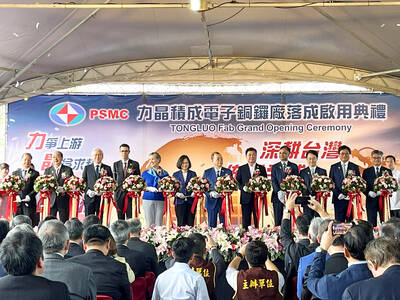With regard to its environmental, social and governance impacts, CTBC Bank (中信銀行) voluntarily adopted the UN Principles for Responsible Banking (PRB) in 2019. In accordance with the PRB’s implementation requirements, the bank released its 2022 Responsible Banking Principles Report on Friday. CTBC Bank is the first bank in Taiwan to adopt the latest international impact analysis tools and undergo third-party assurance in disclosing its implementation goals in its areas of influence, along with its 2022 work results and major points of progress for last year.
The PRB was jointly launched by the UN Environment Program Finance Initiative (UNEP FI) and more than 30 international financial institutions in 2019 to serve as an important benchmark for the global financial industry’s implementation of the UN Sustainable Development Goals (SDGs) and the Paris Agreement. Banks around the world that already voluntarily comply with the PRB include two-thirds of Global Systemically Important Banks, and their total assets amount to US$90 trillion.
CTBC Bank is responding to the PRB’s calls for leveraging its economic impact to promote sustainability. The newly released report applies the impact analysis tools and self-disclosure reporting framework of the UNEP FI in responding to all kinds of international sustainability indicators. It has compiled Taiwanese government sustainable development statistics, research reports and other information to identify the on-the-ground sustainability needs of core operating locations and business locations, and further analyzes the potential impact of the bank’s business and services, taking climate change and inclusive finance as priority areas of influence to set long-term goals for promotion. While following the official guidelines of the UNEP FI, CTBC Bank uses the impact analysis tools it provides even more rigorously to ensure that its priority sustainability areas and key tasks more closely match the needs of global sustainability.

Photo courtesy of CTBC Bank Co
CTBC Bank actively promotes low-carbon operations and transition to help mitigate climate change. Following the science-based targets set by CTBC Financial Holding Co (中信金控), CTBC Bank has established action plans for medium-to-long-term carbon reduction targets in its areas of investment and financing, including commercial real estate, electricity generation projects and general industries. Compared with Taiwanese financial institutions that have passed the Science-Based Targets initiative (SBTi) review, CTBC Bank has included the listed counter stocks, bonds, ETFs and mutual funds of the medium and long-term credit and investment aspects of entire industries within its target range, giving it the most comprehensive range of assets for promoting reduced emissions. Furthermore — in addition to its core operational area — Taiwan, CTBC Bank’s range for implementing its action plans also includes its overseas branches and its subsidiaries in Japan, the US, Canada, Indonesia and the Philippines, giving its carbon-reduction efforts the widest coverage in Taiwan’s banking sector.

ARTIFICIAL INTELLIGENCE: The chipmaker last month raised its capital spending by 28 percent for this year to NT$32 billion from a previous estimate of NT$25 billion Contract chipmaker Powerchip Semiconductor Manufacturing Corp (力積電子) yesterday launched a new 12-inch fab, tapping into advanced chip-on-wafer-on-substrate (CoWoS) packaging technology to support rising demand for artificial intelligence (AI) devices. Powerchip is to offer interposers, one of three parts in CoWoS packaging technology, with shipments scheduled for the second half of this year, Powerchip chairman Frank Huang (黃崇仁) told reporters on the sidelines of a fab inauguration ceremony in the Tongluo Science Park (銅鑼科學園區) in Miaoli County yesterday. “We are working with customers to supply CoWoS-related business, utilizing part of this new fab’s capacity,” Huang said, adding that Powerchip intended to bridge

Microsoft Corp yesterday said that it would create Thailand’s first data center region to boost cloud and artificial intelligence (AI) infrastructure, promising AI training to more than 100,000 people to develop tech. Bangkok is a key economic player in Southeast Asia, but it has lagged behind Indonesia and Singapore when it comes to the tech industry. Thailand has an “incredible opportunity to build a digital-first, AI-powered future,” Microsoft chairman and chief executive officer Satya Nadella said at an event in Bangkok. Data center regions are physical locations that store computing infrastructure, allowing secure and reliable access to cloud platforms. The global embrace of AI

RIDING AI WAVE: : Most of its NT$15bn capital budget would be spent on packaging technologies used in AI and HPC chips and advanced testing technology, it said Chip testing and packaging service provider Powertech Technology Inc (PTI, 力成科技) plans to increase this year’s capital expenditure by 50 percent to expand capacity to meet growing demand for advanced memorychips used in artificial intelligence (AI) products. The company proposed to spend NT$15 billion (US$460.94 million) to expand advanced capacity and equipment, compared with a budget of NT$10 billion it planned three months ago. “We are seeing a recovery in market demand as well as new business opportunities. We will spend heavily on advanced packaging” equipment, Powertech chief executive officer Boris Hsieh (謝永達) told investors on Tuesday. “We will focus on ramping

INFLATION WATCH: A rate hike in March would help keep inflation at 2.16 percent this year, although a weak currency and higher electricity rates are an issue, S&P said Moody’s Ratings and S&P Global Ratings have reaffirmed Taiwan’s sovereign credit ratings at “As3” and “AA+” respectively with a stable outlook on the back of high income and wealth levels, a strong institutional framework and robust external positions. The affirmations came as Taiwan’s economy is gaining momentum after quarters of slowdown induced by stubborn global inflation and monetary tightening. Taiwan’s strong fiscal and external buffers have improved relative to peers as evidenced by recent shocks linked to the COVID-19 pandemic and the ongoing US-China technology dispute, the two ratings firms said. “Taiwan stands as the epicenter of the global semiconductor supply chain, accounting